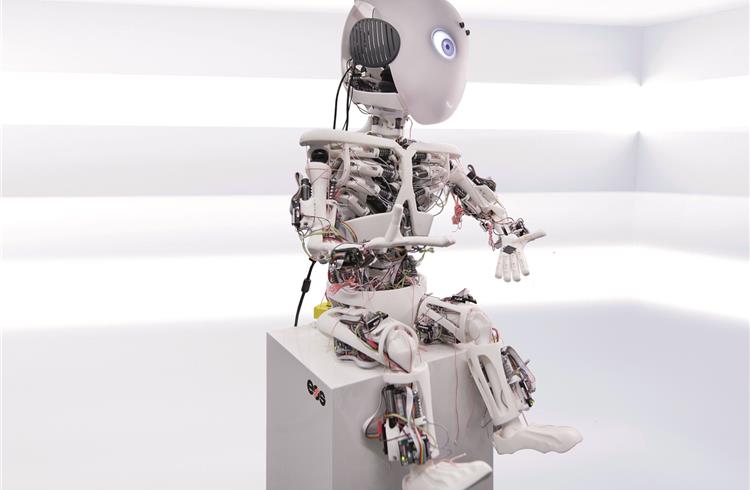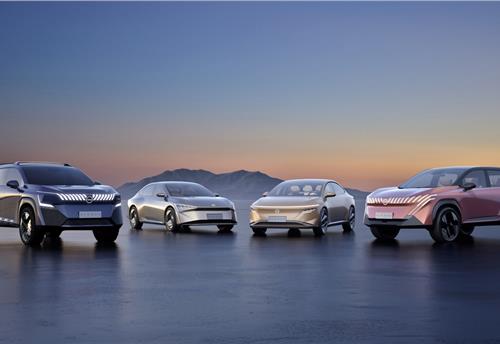Research project looks to advance humanoid robotics to capability of human body
The 'Roboy' research project at the Technical University of Munich replicates the human musculoskeletal system to advance robotics.
The 'Roboy' project at the Technical University of Munich ois looking to advance humanoid robotics to the capability of human bodies. The vision is to iteratively improve Roboy models until the performance is comparable to humans in dexterity, robustness and flexibility.
EOS, the global technology and quality leader for high-end Additive Manufacturing (AM) solutions, has announced its support of the Swiss society Devanthro and the Roboy project.
The first prototype – Roboy Junior – has muscles and tendons rather than motors in the joints. It has been developed under substantial usage of AM: The complete skeletal body structure of Roboy, which encases his bones and muscles, has been built with EOS systems for Plastic Additive Manufacturing. The use of industrial 3D printing has several key advantages; among them is the possibility of building complex functional geometries as well as sustaining a fast and iterative hardware development.
Benefits of additive manufacturing
Additive Manufacturing allows for highly complex structures which are also extremely light and stable. It provides a high degree of design freedom, optimisation and integration of functional features, and the manufacture of small batch sizes at economical unit costs.
The Roboy development benefits from all these advantages: Building complex functional geometries without classical fabrication constraints allows the Roboy team to implement functionality directly into the geometrical parts. Consequently, build complexity is reduced, and many of the otherwise necessary assembly steps can be dispensed of. For example, Roboy’s hands and forearms are manufactured in one piece, including several joints and individual phalanxes for each finger.
Due to Roboy’s maximal mechatronic complexity on a minimal space, it is not possible to validate some project requirements in simulation. Therefore, the development team needs to be able to test the robot itself. AM is key to this because it allows the fast manufacturing of individual components and the modulariaation and parameteriaation of the robot’s construction, enabling an iterative hardware development.
According to Rafael Hostettler, Roboy project leader, “In software development, rapid development cycles allow software improvement by testing it ‘in the wild’. Additive Manufacturing allows us to apply this approach to robotics, enabling a rapid development to find optimal functional parts in a fraction of the time. EOS’ AM technology is a key component for doing this as it enables the iterative hardware development that is crucial for our project.”
In the future, with the increasing advances in Artificial Intelligence and robotics, robots will play a much more prominent role both in society and at work – to the point that especially dangerous and repetitive tasks can be completed by robots.
In this context, building robots with similar morphology to the human body yields critical advantages over classical robotic approaches. Firstly, the human musculoskeletal system is a proven solution that leads to dexterous, dynamic and robust robots. In addition, a human-like robot eases interaction between human and machine significantly, making it more intuitive and natural.
Dr. Adrian Keppler, chief marketing officer (CMO) at EOS, says: “While a larger number of companies focuses on AI development, only a very small number of projects worldwide develop humanoid robotics. Therefore, we are all the more proud to support the renowned Roboy project and see its meaning. As the strengths of Additive Manufacturing lie in those areas where conventional manufacturing reaches its limitations, EOS’ technology is the ideal solution for a research project as ambitious as Roboy.”
RELATED ARTICLES
Kia displays EV5 and Sonet SUVs for Chinese market
Kia has unveiled a number of key models and new technologies for Chinese customers at the 2024 Beijing International Aut...
Nissan targets growth in China, unveils four NEV concepts at Beijing Motor Show
The two EVs and two plug-in hybrids are a joint effort with Nissan’s local partner Dong Feng and aimed to better address...
Lamborghini unveils Urus SE ahead of Auto China 2024
Electric-only range of 60km helps reduce emissions by 80%.





 By Autocar Pro News Desk
By Autocar Pro News Desk
 16 Feb 2017
16 Feb 2017
 4687 Views
4687 Views









